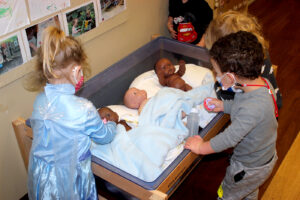We chose to commit our toddler classroom and ourselves to learning more about equity, equality and justice. We know that to be actively anti-racist, it is not enough to only teach children to be kind, but that we must explicitly teach the pitfalls of racial and social disparity in our everyday classroom experiences.
One action step we took was paying close attention to the print media available in our classroom. When choosing books on our shelves, we made a point to ensure that every book contains, in part, non-status quo representation – be it differing abilities, gender expressions or racial representation. We choose to highlight Black and brown authors. We took time to reconsider classic books that are typically in the classroom, and made adjustments to use books that meet the same content goals but show better representation of children in all their differences.
Classroom activities that meet our goals of inclusion and meet Ohio’s Early Learning Development Standards include:
- Mixing paint to talk about different skin tones and using that paint and mirrors for self portraits
- Using pictures of inventions by Black and brown creators as writing provocation
- Listening to stories of real Black heroes, written in their own words
- Sharing stories orally to showcase different ways of recording history
- Labeling common items around the classroom in different languages
- Creating “Black Lives Matter” and “Love is Love” flags for our classroom and consistently referencing them and their meanings
- Adding Dr. Becky Bailey’s “Baby Doll Circle Time” to our weekly curriculum to practice social-emotional skills and empathy
- Adding baby dolls with not only different skin colors and features, but different hair textures and abilities (for example, a baby doll missing an arm isn’t broken but rather is a baby with less limbs than others, but is just as valuable and deserving of being played with)
- Having honest, straight forward conversations about differences in physical features
- Talking about injustice, giving children a basic understanding that some people receive worse treatment because of things they cannot control, such as skin color, hair texture, gender expression, or differing abilities
We know that this work is an on-going, ever-changing endeavor. We are committed to growing and learning as adults, and helping this next generation obtain the tools they need to have true empathy and break cycles of generational oppression.



Click on images to enlarge.


